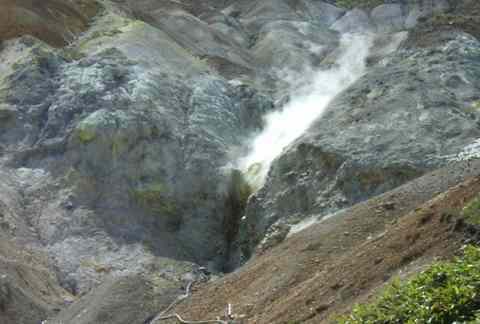Manza-Karafuki
Hoshimata, Tsumagoi city, Agatsuma county, Gunma pref., Japan
Occurrence
Sulphur deposit around active fumaroles associated with the activity of Kusatsu-Shirane volcano. Volcanic gas released from the fumarole at the andesite fissures of Miocene - Pliocene Takai Volcanic Rocks.

Outcrop of active fumaroles. The fissure releasing white gas is fumarole. The gray host around the fumarole is andesite of Takai Volcanic Rocks. The yellow beds are sulphur. Note that no plants grow near the fumarole as it releases toxic hydrogen sulfide. Sulphur was formed by reacting H2S in volcanic gas with O2 in air:
2H2S (Hydrogen sulfide) + 3O2 >> 2H2O + 2SO2
SO2 + 2H2S >> 3S (Sulphur) + 2H2O
Reported Minerals
- Sulphur
Localities
- Manza-Karafuki (Sulphur)
- Iwo Jima (Sulphur)
- Owakutani valley (Sulphur)
- Mount Osore (Sulphur)
- Yugama (Sulphur melt)
- Noboribetsu-Oyunuma Pond (Spherical sulphur, Black)
- Niseko-Oyunuma Pond (Spherical sulphur, Black)
- Mount Iou-dake (Sulphur lava)
- Izu-Oshima Island (Cu minerals)
- Mount Nasu (Sulfate)